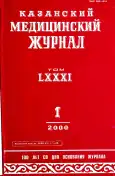Treatment of damage to the extensors of the fingers
- Authors: Nettov G.G.1, Safin R.D.1
-
Affiliations:
- Научно-исследовательский центр Татарстана “Восстановительная травматология и ортопедия”
- Issue: Vol 81, No 1 (2000)
- Pages: 40-41
- Section: Theoretical and clinical medicine
- URL: https://journal-vniispk.ru/kazanmedj/article/view/96231
- DOI: https://doi.org/10.17816/kazmj96231
- ID: 96231
Cite item
Full Text
Abstract
The nature of operative and treatment methods depending on the terms of trauma and injury levels in 134 patients with injuries of hand finger extensors is established. The treatment method stereotype of injuries of hand finger extensors is developed. The internal splinting is typical and the most adequate treatment method for the 1st injury zone; the buried tendon sutures with temporal (to three weeks) fixation of the joint by the wire to accretion of the sutured ends of the injuried tendons are typical for the 2d zone; the primary and secondary tendon sutures with the palmar plaster bandage to accretion of tendons are typical for the 3d zone, the most favourable zone for recovery; the primary or secondary tendon sutures with the absence of defect butween tendon ends are typical for the 4th zone, and with defect more than 3—5 sm the free bridge-like plasty by autotransplant is typical. In chronic injuries of one — two finger extensors when defect is more than 5 sm the transposition is advisable, that is switching the distal extensor end over to the new motor muscle.
Keywords
Full Text
##article.viewOnOriginalSite##About the authors
G. G. Nettov
Научно-исследовательский центр Татарстана “Восстановительная травматология и ортопедия”
Author for correspondence.
Email: info@eco-vector.com
Russian Federation, Казань
R. D. Safin
Научно-исследовательский центр Татарстана “Восстановительная травматология и ортопедия”
Email: info@eco-vector.com
Russian Federation, Казань
References
Supplementary files





